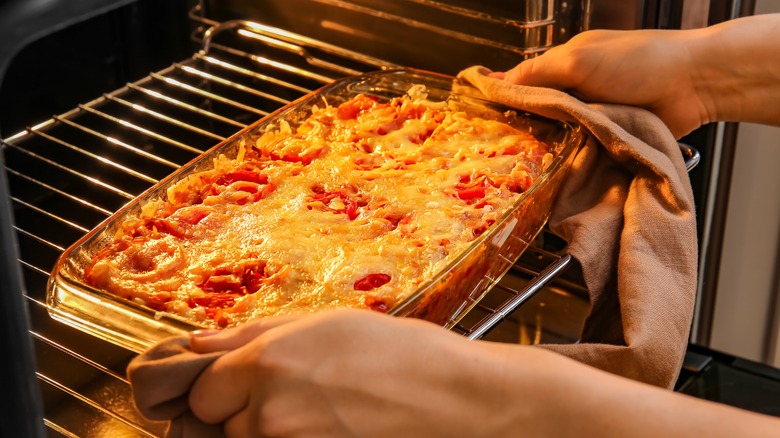What Is Hotdish? Minnesota's Most Famous Food, Explained
If you're not from Minnesota or the upper Midwest, you might not be familiar with the delicacy known as hotdish. Yet the humble food, more of a category than a specific recipe, is a true Minnesota icon. It's a dish emblematic of the region's low-key, unpretentious, and salt-of-the-earth reputation. But what is hotdish? Well, for starters, there is no one specific recipe. It is more of a template upon which many Minnestonans have built their own family recipes. But in general, hotdish is a meal that consists of veggies, a starch, a protein, a canned soup base, and a crispy topping such as tater tots or bread crumbs all cooked together in one big, well, hotdish.
However, the exact ingredients in hotdish do vary, with some home cooks preferring rice to pasta, or the reverse. And some hotdish recipes call for a tomato base rather than a soup base. And those in Wisconsin, for example, might be more inclined to add a local Wisconsin cheese topping. (Though Minnesotans might have a thing or two to say about the legitimacy of a Wisconsin hotdish.)
And though hotdish may seem a bit humble on the surface, that doesn't make this food any less delicious (or iconic). In fact, the dish has come to be representative of the homey, welcoming, and nostalgic culture of Minnesota. The history of the hotdish is inextricably tied to the state's history and continues to play a part in its Minnesota-nice culture.
A hot dish of history
Hotdish is as inextricably tied to Minnesota's identity as cornfields, state fairs, and piles of winter snow. But how, exactly, did hotdish come to be? Well, it has its roots in the early 20th century. According to the documentary short "Minnesota Hotdish: A Love Story," the dish's earliest predecessor was the hot pot, a food that originated in the 1910s, as many Americans struggled to make ends meet during World War I rationing. Hot pot was marketed to many Americans as an easy way to stretch a single pound of meat to feed an entire family. These meals were cooked in one pot, and contained all aspects of a rounded meal, including protein, vegetables, and starch.
And though hot pot was a popular dish, it wasn't until the 1930s that the dish known as hotdish fully developed as a Minnesota staple. This was because of the financial constraints brought on by the Great Depression. Minnesota, like most states, faced a lot of challenges during this time, especially among farmers in the region. It was during this time that the first recipes for hotdish emerged. Unlike hot pot, these recipes were a single dish joined together by starches and a canned soup base, which was more widely available during the time. However, the dish fully came together in 1956, when tater tots were first released. Tots became a key ingredient in many hotdish recipes, serving as a staple in the one-dish dish.
Not a casserole, thank you
Now, you might be thinking that hotdish sounds an awful lot like a casserole, a similarly layered dish that consists of various ingredients mixed together in a large pan and cooked. However, these two dishes are not interchangeable. So what differentiates a hotdish from a casserole? For starters, the purposes of the two dishes are quite different. While casseroles can serve many purposes, from being a side, a main, and sometimes even a dessert, hotdish is always a main dish.
Additionally, there is no guidance as to what makes a casserole a, well, casserole. Anything can be a casserole so long as it combines several ingredients in a casserole dish. However, a hotdish generally follows a similar format and features the same general ingredients, including protein, starch, soup base, and topping. So while hotdish is technically a casserole, not every casserole is a hotdish.
Hotdish is one of those foods that, like dishes such as brisket and mac and cheese, features almost endless variations depending on the family and region in which it is produced. Many Wisconsinites, for example, like to add cheese to their hotdish. Others add pasta rather than rice to their recipe, mirroring the similarly popular midwestern goulash, which also features a smattering of ingredients combined with macaroni noodles to create a delicious, if eclectic, soup. But regardless of how you make or enjoy your hotdish, it's worth trying it out for yourself and enjoying a little bit of the Minnesotan spirit.


